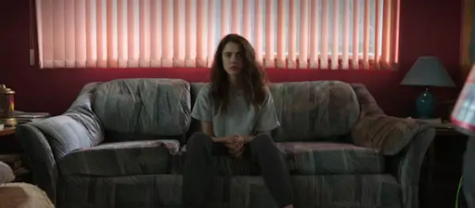Netflix’s Maid Reveals Society’s Twisted Definition of Domestic Violence

(Photo Credit: Variety Magazine)
With nowhere else to go, Alex, along with her daughter Maddy, spends the night in her car after fleeing her abusive, alcoholic partner. Later in the first episode of Netflix’s series Maid, the mother and daughter fall asleep on the floor of a ferry station, where Alex’s eyes fill with tears as Maddy falls asleep in her arms. After not being able to gain support from her friend or mother, Alex has nowhere and no one to turn to.
With her options for jobs limited due to not being able to afford daycare for her daughter, Alex works as a maid at a local cleaning business. As Alex tries to build a better life for Maddy, it becomes apparent that she does not consider herself a victim. Alex has experienced both emotional and financial abuse, yet she seems to believe that domestic abuse solely entails bruises and open wounds.
When speaking to a social services worker, Alex’s flawed definition of domestic abuse, heavily influenced by society, is revealed.
“Well, there’s shelters for domestic violence victims, but you need to go on record with your abuse.”
“I’m not abused,” responds Alex, while shaking her head repeatedly and holding Maddy tightly in her arms.
Despite her abusive partner who prevents Alex from working by cutting off her phone and drinking to the point where he quickly turns violent, Alex is reluctant to label herself a victim of domestic abuse. Alex’s hesitancy to acknowledge domestic abuse reveals her own disregard for the abuse she suffers. The series also explores what happens when society fails to recognize the very real, though often less discussed, impact of financial and emotional abuse.
The series comes at a time when the pandemic’s impact shows no signs of waning. If anything, it’s brought issues once invisible to the front and center, issues like domestic abuse.
Ana Bella established a foundation with the goal of helping survivors of domestic violence. “We’ve been getting some very distressing calls, showing us clearly just how intense psychological, as well as physical mistreatment, can get when people are kept 24 hours a day together within a reduced space,” she said in an interview with The New York Times,
During the pandemic in the United States, individual states reported an increase in domestic abuse incidents anywhere from 21 to 35 percent. However, statistics regarding domestic abuse incidents may not fully represent the status quo, as many domestic abuse cases go unreported. Though women like Alex have been abused, they do not consider emotional and financial abuse as “real” abuse.
The exacerbation of domestic abuse during COVID-19 is merely the tip of an iceberg; forms of domestic abuse including financial and emotional abuse have been unrecognized by society for decades.
According to The National Network to End Domestic Violence, “The short- and long-term effects of financial abuse can be devastating. In the short-term, access to assets is imperative to staying safe. Without assets, survivors are often unable to obtain safe and affordable housing or the funds to provide for themselves or their children. With realistic fears of homelessness, it is little wonder that survivors sometimes return to an abusive partner.”
Though financial abuse occurs in 99% of domestic violence cases, the danger of financial abuse is often overlooked or not taken as seriously. Forms of financial abuse include forbidding the victim to work, not providing the victim access to bank accounts, and giving the victim an “allowance,” among many others.
Throughout the pandemic, warning signs of financial abuse may be easily interpreted as financial distress or unemployment. Traditionally, domestic abuse was defined as one primarily of physical violence. The narrow definition of abuse discouraged victims of financial abuse to come forward. As a result, many women experiencing this perilous form of abuse will stay with their abusers, which puts them and their children in great danger.
Viewers see this through Alex’s story. Towards the end of Maid’s first season, Alex returns to her abuser after being kicked out of a friend’s house. At the beginning of the ninth episode, the camera frame shows Alex at the bottom of a pit. The pit’s symbolism conveys how financial abuse isolates victims and traps them in a kind of hole, as women like Alex become financially dependent on their abusers.

It’s only when Alex realizes how returning to her abuser negatively affects Maddy that she decides to metaphorically climb out of the “pit” she is confined in.
Emotional abuse can be just as subtle and dangerous as financial abuse. The widespread myth that domestic abuse must involve violence prevents also many women from acknowledging the abuse they have suffered. Domestic abuse can be repeating incidents of controlling, violent, and threatening behavior by a partner.
Examples of emotional abuse are isolating the victim from other people in their lives, demanding access to the victim’s phone and email, and threatening to hurt the victim if they leave.
A common form of emotional abuse is verbal abuse. A partner can be verbally abusive even if their words are said in a loving voice or calm tone. Additionally, verbal abuse can easily be disguised as a joke by abusers. Though emotional abuse does not leave bruises or scars, this form of abuse traumatizes and disempowers victims.
During the time Alex spends at a domestic violence shelter, she becomes close with another domestic abuse survivor named Danielle. Alex tells Danielle that though her partner never physically hurt her, he was constantly violent and threatening. One instance Alex shares with Danielle is when her abuser punched a wall near her head while screaming at her.
“Before they bite, they bark,” Danielle said in response. “Before they hit you, they hit near you. Next time, it was going to be your face.”
The pandemic has prevented many more victims from leaving their abusers before they “bite.” Though victims might acknowledge that their abuser’s “bark” will soon turn into a “bite,” victims often do not have the resources to leave their relationship. Moreover, the pandemic has made it more difficult for domestic violence victims to reach out for help.
“When we chat by phone or video with a client experiencing domestic violence, we never know if there’s someone else in the room with them,” said Dr. Sashalee T. Stewart, a psychiatrist at Novant Health Psychiatry. “They may not have space to speak freely like they did prior to the pandemic.”
Financial abuse is violence. Emotional abuse is violence. Unfortunately, a large handful of victims are unable to free themselves from the “pit.” They are stuck. They are stuck in an environment that will leave them with scars, both mental and physical. They are stuck in a situation where they have no sense of safety, even in their own homes.
By changing how we talk and think about domestic violence, victims of such abuse will feel more encouraged to seek help.
Often, victims of domestic violence are asked why they did not leave their abusive relationship sooner. However, fleeing an abusive partner is complicated because domestic abuse victims are controlled, threatened, and manipulated. More women experiencing financial or emotional abuse will come forward when outsiders stop treating these forms of abuse as trivial.
When society stops undermining the seriousness of financial and emotional abuse, so will the victims.

















![Dr. Zanita Kelly, Director of Lower and Middle School, pictured above, and the rest of Westridge Administration were instrumental to providing Westridge faculty and staff the support they needed after the Eaton fire. "[Teachers] are part of the community," said Dr. Kelly. "Just like our families and students."](https://westridgespyglass.org/wp-content/uploads/2025/03/dr.-kellyyy-1-e1748143600809.png)













































